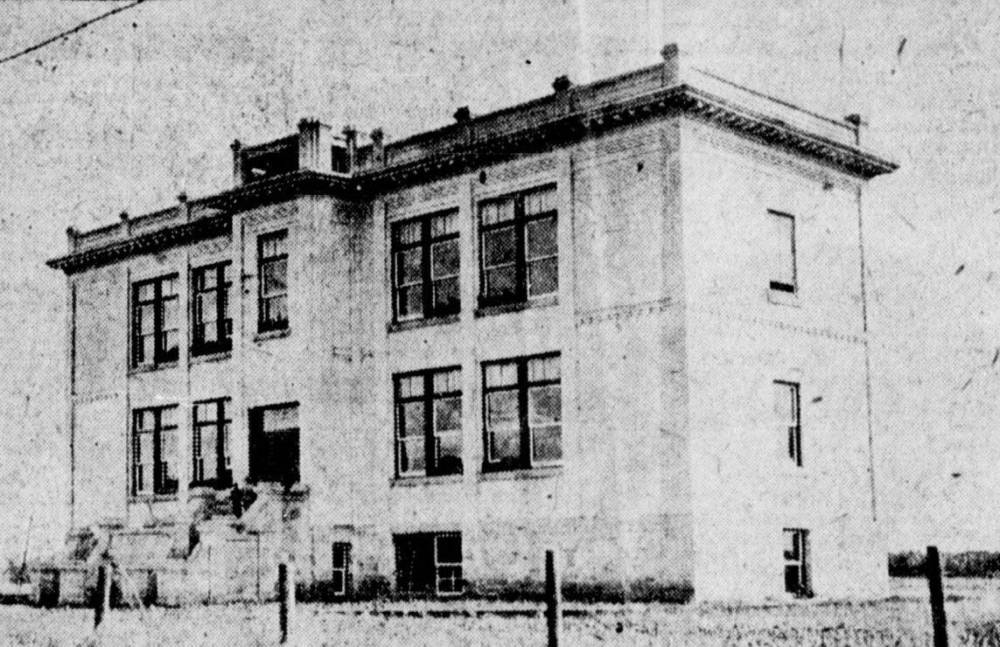From Bishop Grandin to Abinojii Mikanah
Advertisement
Hey there, time traveller!
This article was published 05/04/2023 (942 days ago), so information in it may no longer be current.
Winnipeg city council has voted to change the name of Bishop Grandin Boulevard to Abinojii Mikanah.
Abinojii means “children” and Mikinah means “street” in the Anishinaabemowin/Ojibwa language. Also changing will be Grandin Street to Taapweewin Way. Taapweewin means “truth” in Michif, a language of the Red River Métis.
These changes are due to a re-evaluation of the legacy of Bishop Vital Julien Grandin — from being considered a pioneer in the development of Canada’s northwest he is viewed as a key architect of its Indian residential school system.

Supplied photo
Bishop Grandin Boulevard was chosen in 1978 as the name of Route 165 because it was bilingual and a nod to the old Grandin School, pictured above in a Winnipeg Tribune photo from 1922, which once stood in the vicinity of Route 165 and Pembina Highway.
Changing a street name was once quite common. From the time of Winnipeg’s incorporation until shortly after the unification of the 12 municipalities into “Unicity” in 1974, it was done hundreds of times. Most changes were functional in nature, as they eliminated duplicate street names, or one was chosen over another when two streets eventually grew together.
It is rare, perhaps unprecedented, for the city to change the name of a major street due to its meaning.
There have been minor examples, of course. St. James’ Berlin Street was renamed Lyle Street during the First World War, and Elmwood’s Rodent Street become the more palatable Brazier Street in 1907. However, when Winnipeg School Division changed the name of Cecil Rhodes School due to his role in the creation of what became South Africa’s apartheid system, Cecil Street, in front of the original building, was left alone.
Bishop Grandin Boulevard was named in 1978, when the $23-million-dollar Fort Garry-St. Vital traffic corridor, also known as Route 165, was nearing completion. On July 19, 1978, city council chose to give the route the alternate name Bishop Grandin Boulevard and to call its major span the Fort Garry Bridge.
A brief article in the following day’s Winnipeg Free Press noted that Bishop Grandin was chosen both because it was bilingual and as a nod to the old Grandin School which once stood in the vicinity of Route 165 and Pembina Highway. It was one of the oldest institutions in the district, operating from 1897 until 1953, when it was amalgamated with another school. The two-storey brick building was then sold off and used commercially until its demolition in July 1972.
One historian noted in a Manitoba Historical Society journal article, published shortly after Route 165’s renaming, that Bishop Grandin was a name that most Winnipeggers would not be familiar with. That, of course, would soon change.
What should we make of the transition from Bishop Grandin Boulevard to Abinojii Mikanah?
History is ever-changing. We add to it with every passing day and our understanding of people and events evolve over time. We have also come to realize that we did a poor job recording the histories of those we considered outside of “mainstream” society.
As we discover more of these forgotten histories, how do we reflect them in the everyday life of our city if our street and other place names were set in stone many decades ago?
We must be willing to make way for new stories and interpretations of our history. The change from Bishop Grandin to Abinojii Mikanah does just that.




